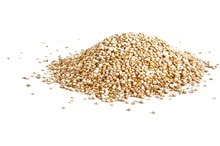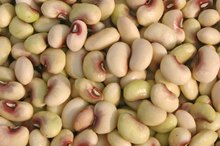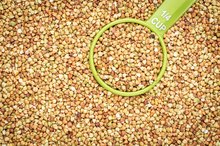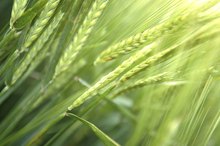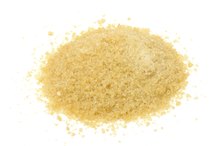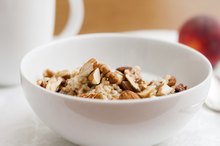What does fact checked mean?
At Healthfully, we strive to deliver objective content that is accurate and up-to-date. Our team periodically reviews articles in order to ensure content quality. The sources cited below consist of evidence from peer-reviewed journals, prominent medical organizations, academic associations, and government data.
The information contained on this site is for informational purposes only, and should not be used as a substitute for the advice of a professional health care provider. Please check with the appropriate physician regarding health questions and concerns. Although we strive to deliver accurate and up-to-date information, no guarantee to that effect is made.
Wheat Germ & Protein
Wheat germ is a tiny part of the entire wheat kernel 2. It is the part that is responsible for germination and the growth of wheat grass. Wheat germ contains dozens of nutrients, including protein 2. Use wheat germ in smoothies, sprinkled on cereal or yogurt or as a cereal on its own to help you boost your daily protein intake 3.
Significance
Protein is an essential macronutrient that you need to consume in relatively large quantities 3. It helps with cellular repair and growth and assists in the transport of vitamins and minerals throughout the body. Eating high-protein foods helps you get the recommended minimum 0.4 g of protein per pound of body weight recommended by the Institute of Medicine. Wheat germ is a source of protein that helps you fulfill your daily protein needs.
- Protein is an essential macronutrient that you need to consume in relatively large quantities 3.
Amount in Wheat Germ
Amino Acids That You Can't Get from a Vegetarian Diet
Learn More
Wheat germ contains about 33 g of protein per cup, but you are unlikely to eat it in such large quantities 3. A more reasonable 1/4-cup serving provides 8 g of protein, 108 calories and 3 g of fat. Compare this to 1 cup of milk, which also contains 8 g of protein, with 80 calories and no fat; or 1 oz. of cooked chicken, with 9 g of protein, 48 calories and 1 g of fat.
- Wheat germ contains about 33 g of protein per cup, but you are unlikely to eat it in such large quantities 3.
- Compare this to 1 cup of milk, which also contains 8 g of protein, with 80 calories and no fat; or 1 oz.
Quality
Proteins are composed of amino acids, nine of which you cannot produce on your own. Most plant proteins are incomplete, meaning they are missing one or more of these essential amino acids. Wheat germ is not a complete protein, such as meat or eggs, but it is high quality when compared to many other plant sources. When you eat a variety of plant proteins daily, including wheat germ, you get all the amino acids you need for a healthy body. Wheat germ contains the branched-chain amino acids arginine and glutamine, which help with muscle growth and repair.
- Proteins are composed of amino acids, nine of which you cannot produce on your own.
- Wheat germ is not a complete protein, such as meat or eggs, but it is high quality when compared to many other plant sources.
Additional Benefits
The Nutrition and Fiber in Crowder Peas
Learn More
Wheat germ contains more than 4 g of fiber per 1/4 cup. Fiber helps regulate digestion and improves cholesterol levels. Wheat germ also provides vitamin E, thiamin, riboflavin, vitamin B-6, folate, phosphorus, magnesium, manganese, selenium and zinc. Consider combining wheat germ with whey protein prior to a strength-training workout to increase your energy during your workout and the muscle-building results afterward.
- Wheat germ contains more than 4 g of fiber per 1/4 cup.
Related Articles
References
- "Flex"; Myth Master; Fact or Fiction: Wheat Germ is a Dinosaur…; Jim Stoppani; April 2008
- USDA Nutrient Database: Cereals Ready-to-Eat, Wheat Germ, Toasted, Plain
- MedlinePlus: Protein in Diet
- Schagen SK, Zampeli VA, Makrantonaki E, Zouboulis CC. Discovering the link between nutrition and skin aging. Dermatoendocrinol. 2012;4(3):298-307. doi:10.4161/derm.22876
- National Institutes of Health. Vitamin E: Fact Sheet for Health Professionals. Updated February 28, 2020.
- Keen MA, Hassan I. Vitamin E in dermatology. Indian Dermatol Online J. 2016;7(4):311-5. doi:10.4103/2229-5178.185494
- Food Allergy Research & Education. Wheat Allergy.
- Berkeley Wellness. University of California. Should Anyone Take Vitamin E?. Published January 24, 2014.
Writer Bio
Andrea Boldt has been in the fitness industry for more than 20 years. A personal trainer, run coach, group fitness instructor and master yoga teacher, she also holds certifications in holistic and fitness nutrition.
